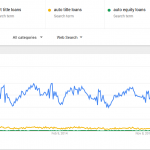California Title Loans
Starting in 2003, mortgage lenders struggled to make new loans. Rather than accepting a stagnant market, financial institutions across the United States decided to lower their lending standards and begin extending mortgage offers to subprime borrowers, or people who otherwise wouldn’t have been considered suitable candidates for mortgages.
The long-term acceptable industry average of mortgage originations to subprime borrowers more than doubled from 2004 to 2006. Since subprime borrowers were more than able to begin making payments on their mortgages from 2004 to late 2006 or early 2007, financial analysts and lenders themselves hadn’t yet reached panic mode.
As 2007 progressed, the total number of mortgage defaults among lenders active in the United States began increasing. Other bad signs of an economy that would likely soon fall began popping up around this time.

California zip code maps
Title Loans in California
Up until this point, traditional lenders – financial institutions, particularly local consumer banks – had largely only extended loans to suitable borrowers in the following forms:
- Car notes.
- Student loans intended for tuition and school-related expenses.
- Long-term, low-interest-rate mortgages used to pay for homes.
- Small business loans.
Once the subprime mortgage crisis fully unfolded and the Great Recession came into full force in late 2007, Americans weren’t able to receive loans unless they were overqualified for loans that lenders would otherwise have extended them without hesitation, not to mention at low interest rates. Virtually all of these loans would require collateral, to boot.
Scrutiny, average interest rates, and minimum monthly payments on loans increased across the United States. Once the Great Recession came to a close, traditional lenders began relaxing their previously-tight lending standards and alternative lenders began popping up, essentially riding the beginnings of a wave that would soon become a decade-long period of positive economic performance.
Many such lenders are those that offer check-cashing, payday loans, and title loans. They don’t offer checking accounts, savings accounts, mortgages, car notes, student loans, or small business loans. However, this new class of financial institutions was defined by small-time lenders that were largely willing to eschew credit scores, lending history, and other traditional qualities that have long been used by lenders as crucial characteristics for determining whether applicants are deserving of funding or not.
Tons of web-based lenders began popping up, too, thanks to the rise of e-commerce, the proliferation of smartphones, and the role of the World Wide Web in Americans’ daily lives.
The loans these new financial institutions offered are known as personal loans, as such lenders don’t care what you spend the funding on.
One Widely Popular Personal Loan Is the Title Loan
Loans fall into two categories: secured and unsecured loans. Secured loans require collateral in exchange for funding. The more valuable and liquid such collateral is, the better financing terms borrowers are likely to receive.
Since many Americans own at least one vehicle, members of this new class of lenders began offering speedy loans that didn’t check borrowers’ credit scores known as title loans. All lenders needed to have was the title to a vehicle in their name. Lenders would retain the right to possess these car titles until loans were paid back. Find out how much money you can get with the Title Loanser car title loan estimate calculator. Since most Americans can’t afford to part ways with their vehicles, title loans quickly proved to be an effective type of personal loan. They remain one of the most popular loans on the modern American consumer lending market as of early 2020.
How Do People Go About Getting Car Title Loans?
If you’ve read this far, it’s clear that title loans in California are likely a good fit for your personal situation. Here’s how to go about getting a car title loan.
Reach Out to Us Immediately
The longer you wait to reach out to us, the longer you’ll have to wait for funding. It’s that simple.
You can apply via our official website, which happens to be secured by Hypertext Transfer Protocol Secure, or HTTPS), technology, meaning all information you submit to us via our website is encrypted – in other words, anything you share with us stays with us. Also, of course, you can simply give us a call during business hours to initiate the application process.
What Documents Are Needed?
You won’t need many documents to sign up for a title loan with us. You’ll need to mail us a clear, legible copy of the documents you need, fax them to us, or – the most common means of doing so – take a picture of them using a smartphone. All modern smartphones’ camera quality will be more than enough to satisfy our requirements.
You’ll need a valid California driver’s license, your car title, proof of employment, and potentially your credit history. A title loan might not be possible if your vehicle’s title currently has a lien against it.
How Do You Get Money Once Approved?
Typically, the entirety of the car title loan process won’t exceed two to three business days. The most important parts of the process are making sure your information is correct before submitting it, that your documents are photographed in sufficient lighting with a suitable camera, and making sure you’ve actually been accepted.
If you’re approved, cash usually won’t take longer than one business day to reach your bank account. In some cases, you may be able to visit us to receive a cash payout.
Fun Facts About Car Title Loans
 Unlike traditional loans – car notes, mortgages, and the like – title loan approval takes less than 24 hours in many cases. Also, title loan lenders are more willing to not require you to apply in person, unlike their traditional counterparts.
Unlike traditional loans – car notes, mortgages, and the like – title loan approval takes less than 24 hours in many cases. Also, title loan lenders are more willing to not require you to apply in person, unlike their traditional counterparts.
Good credit is often necessary to receive even the most abysmal offers on loans from traditional lenders, though credit checks usually aren’t part of the title loan process.
The majority of car title loan providers allow borrowers to pay off their loans early. Many mortgage and car note lenders might accept early payments, though they’ll be required to pay more than they actually currently owe. For example, a penalty will be exercised that essentially means you’ll end up paying what you would as if you only submitted minimum monthly payments for the entire term of the loan.
Keep driving your vehicle. Lenders know that you need your car to get around. Although lenders possess the title while your loan is outstanding, you’ll still be able to drive your car around. Always read your financing agreement’s contract to make sure any presumptions you’ve made about your title loan are, in fact, true. Or click here for our title loan calculator.





